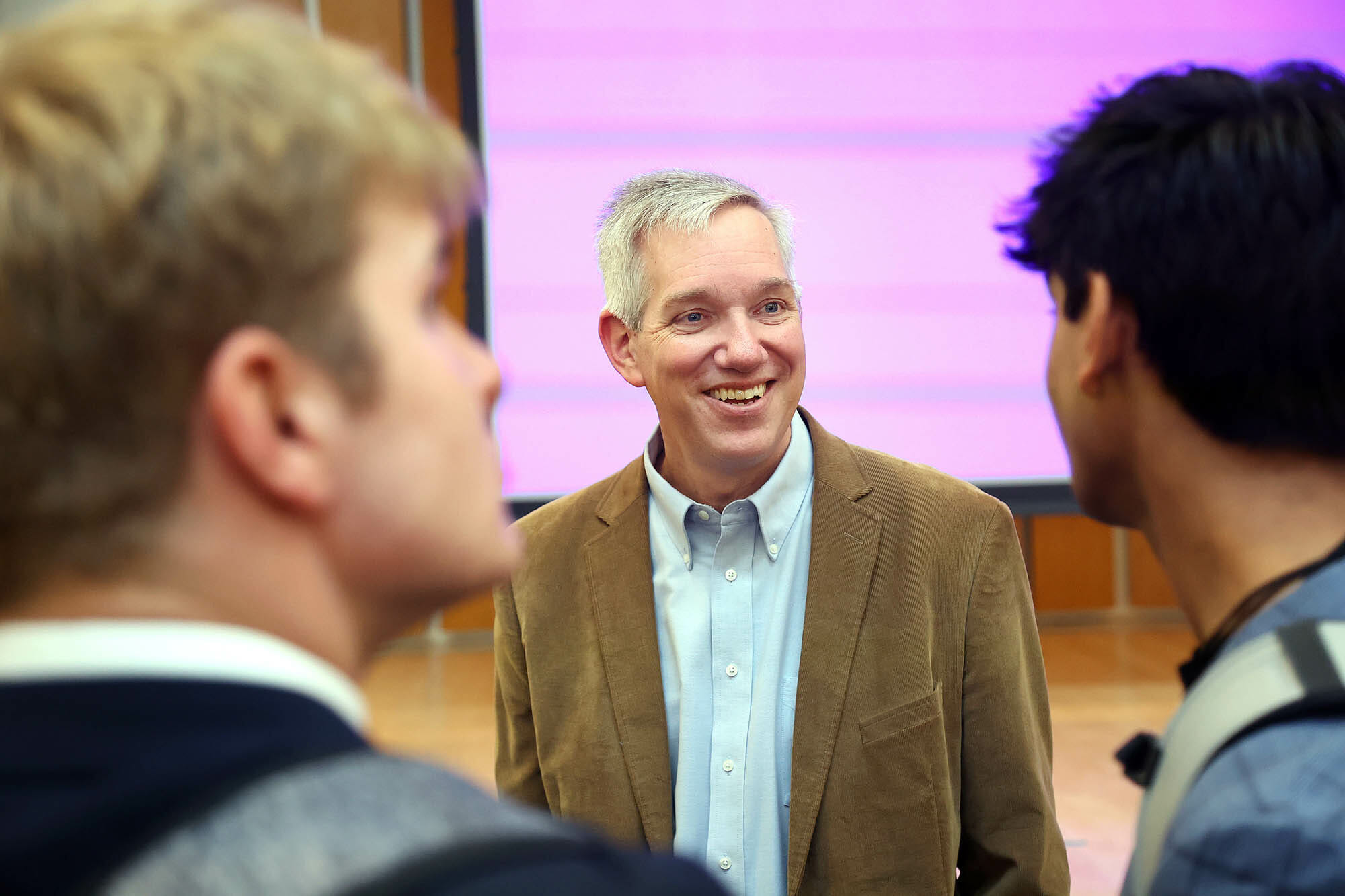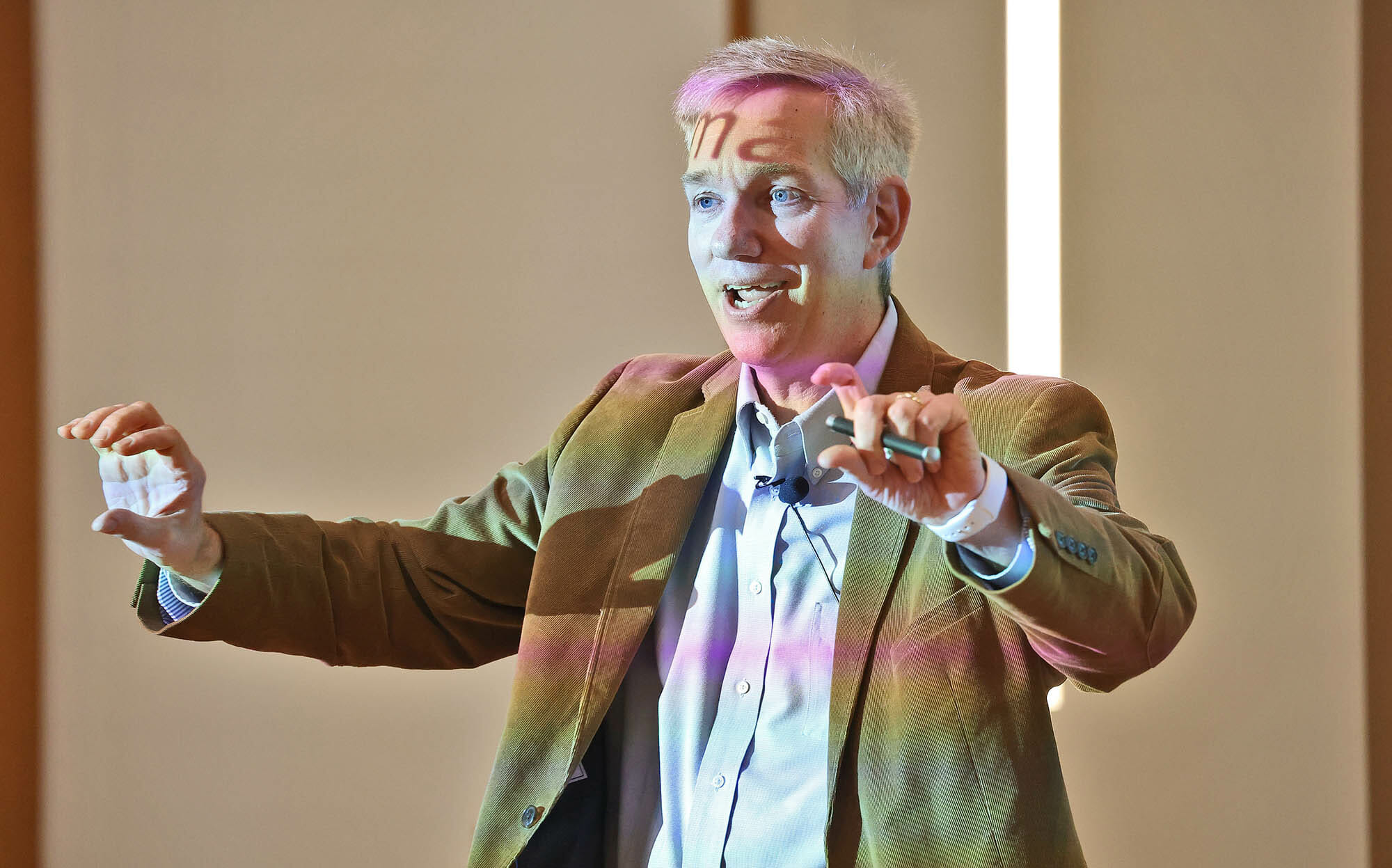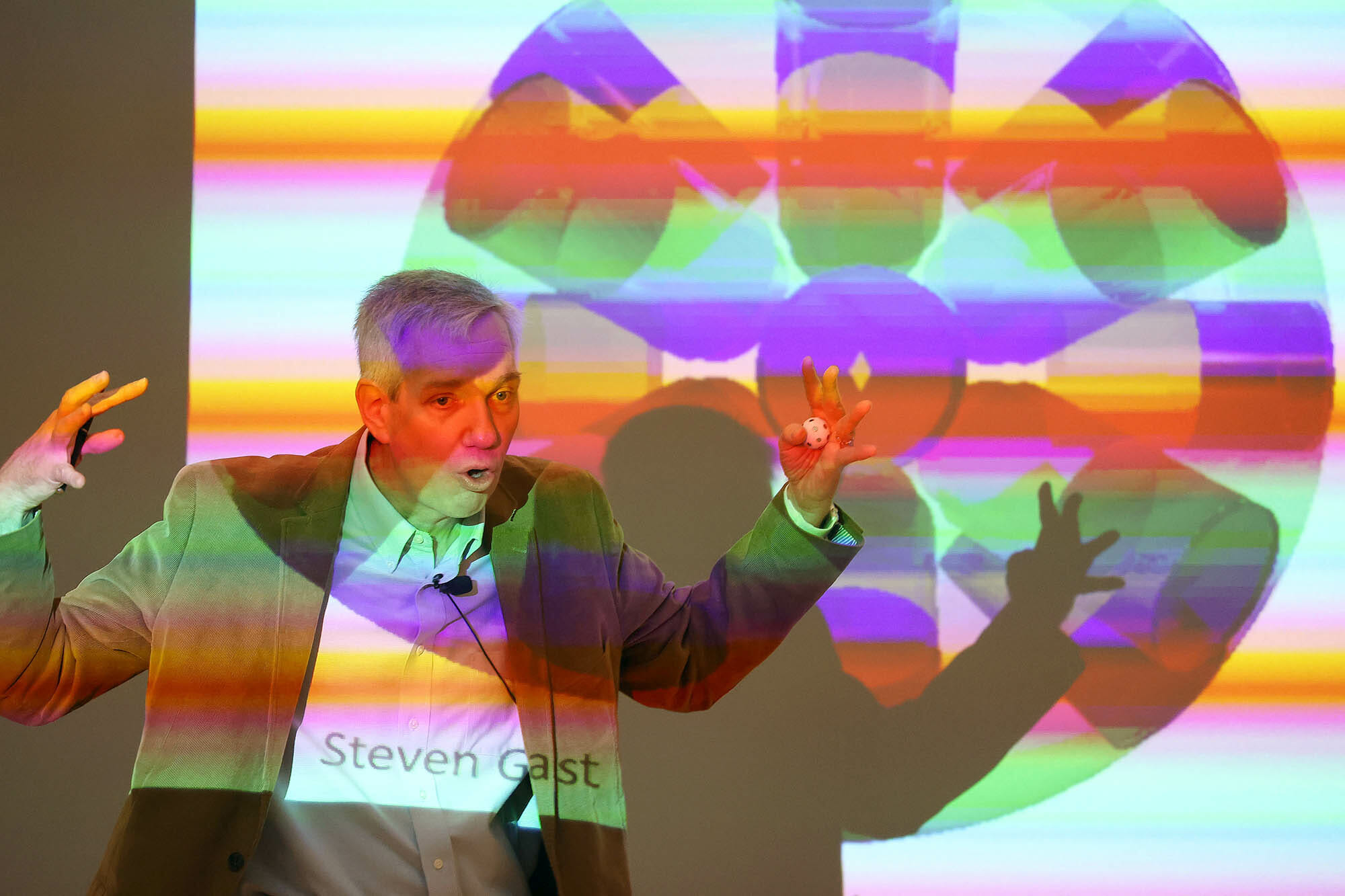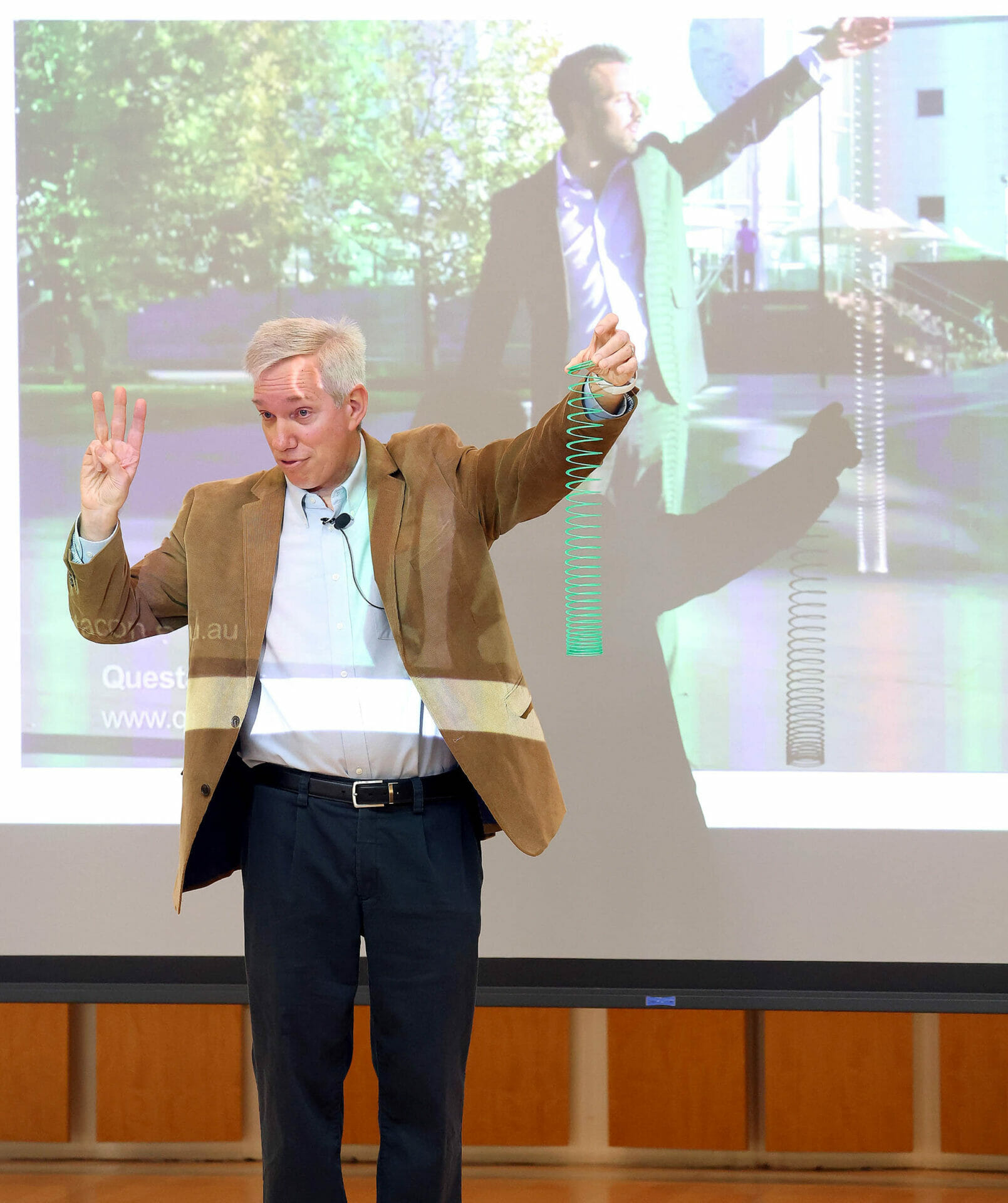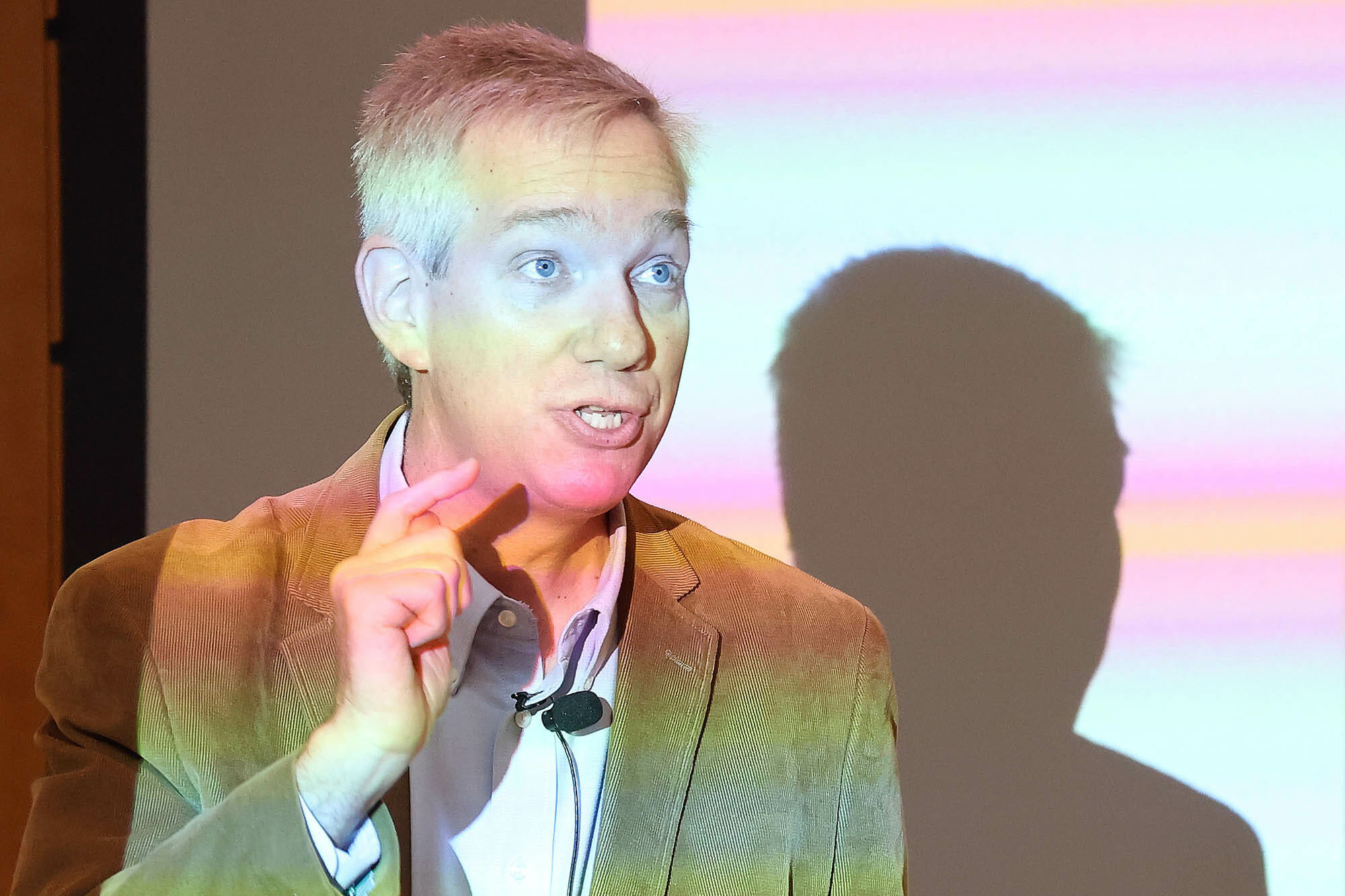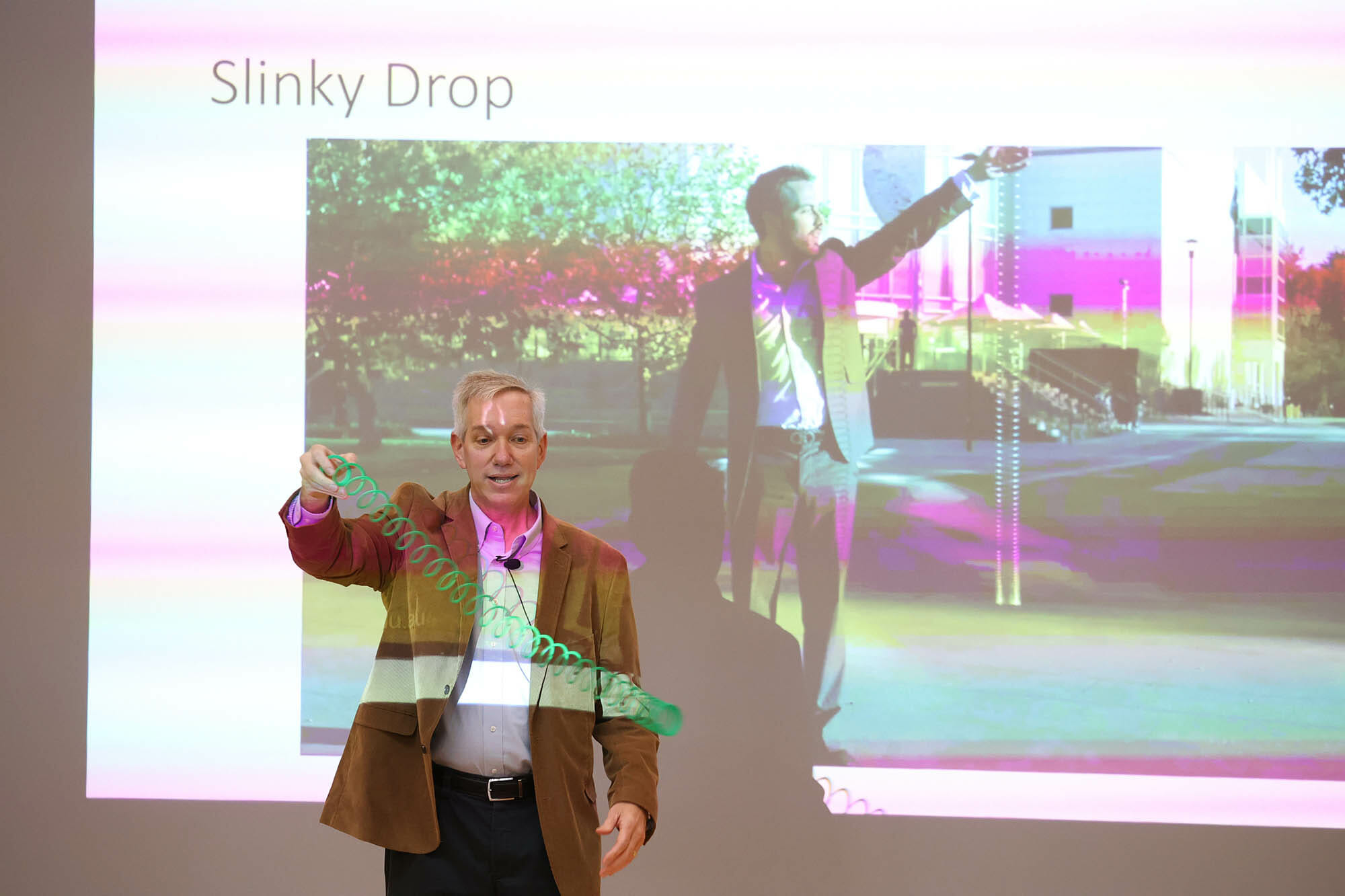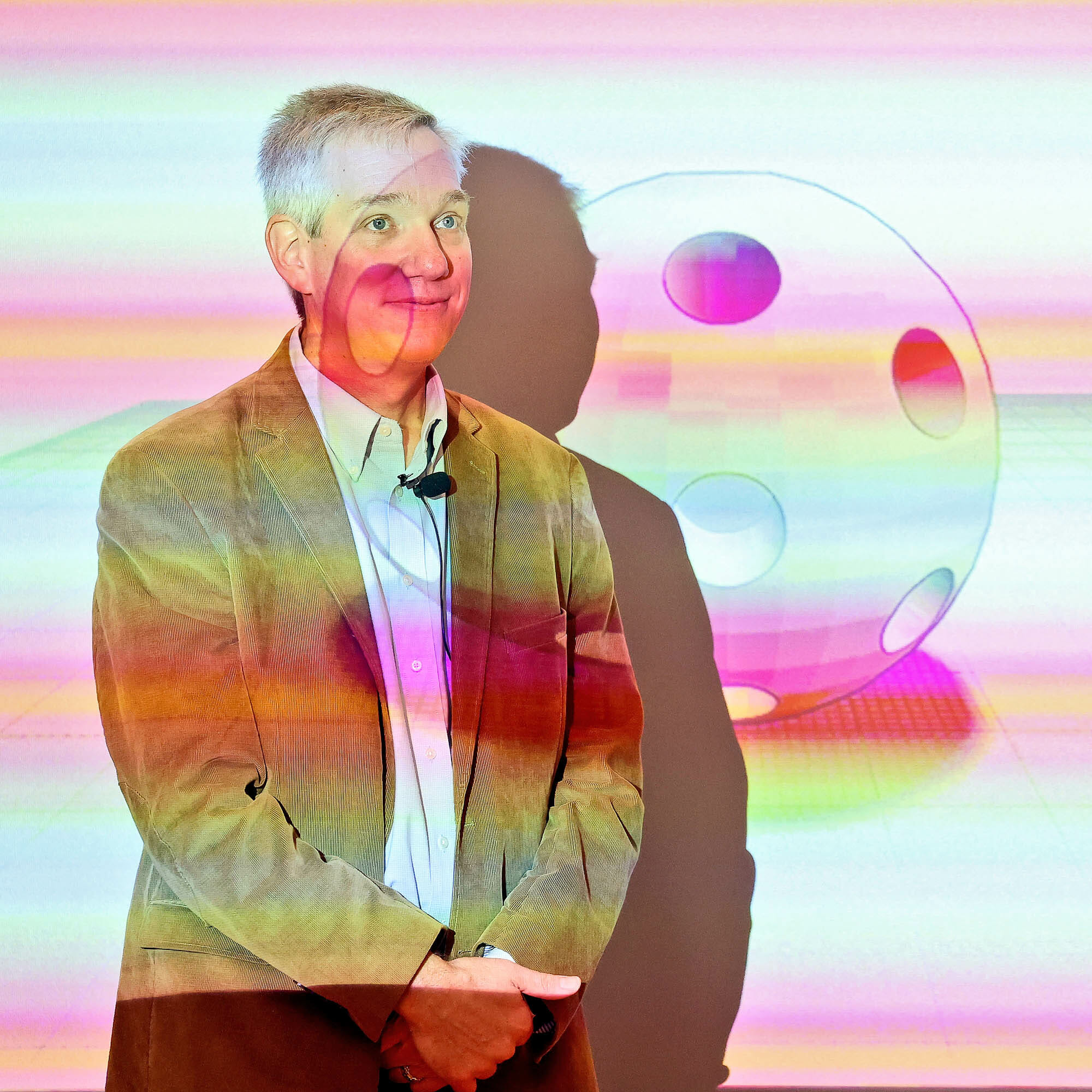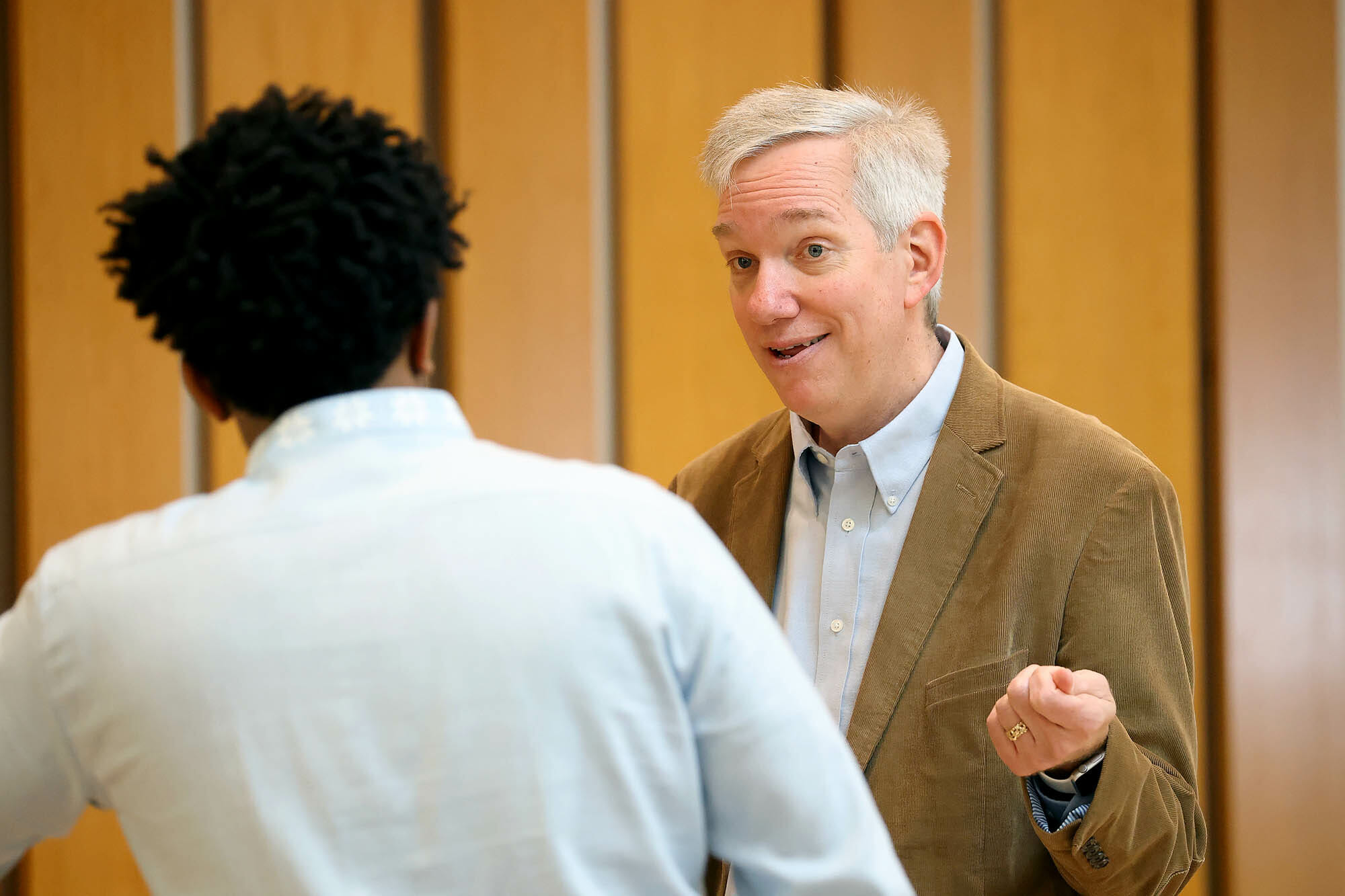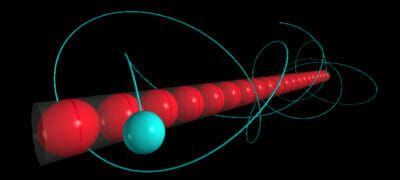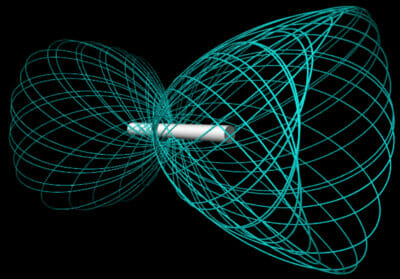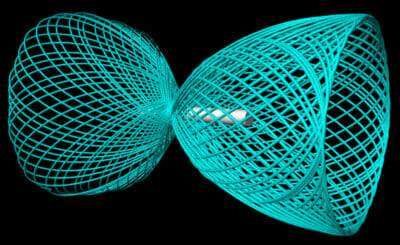On Monday, April 3, the MICDS Upper School was delighted to welcome Dr. Aaron Titus, Teaching Professor in the Department of Physics at North Carolina State University, as the 2023 Harbison Lecturer. He was introduced by Paul Zahller, JK-12 Science Department Chair, with these words:
It is my pleasure to introduce Dr. Aaron Titus, the 2023 Harbison Lecturer. The Harbison Lecture is named on behalf of Mr. Earle H. and Mrs. Suzanne Siegel Harbison ’45. Mrs. Harbison graduated from Mary Institute in 1945, beginning a long lineage of Harbisons to attend the School. For as long as the Harbisons have been members of the School community, they have made MICDS a philanthropic priority—remaining deeply committed to ensuring our students have access to outstanding faculty, great learning spaces, and excellent programming that supplements the classroom experience.
Mr. and Mrs. Harbison established the Harbison Lecture Fund in 1994 to commemorate Mrs. Harbison’s 50th Class Reunion. Its purpose is ‚to fund an annual lecture for students at MICDS featuring a prominent local, regional, or national figure whose topic will support the mission and educational goals of the School.‘ Because the Harbison family strongly values the sciences, the School has historically chosen a leading figure in the sciences to speak to Upper School students.
Dr. Titus is a Teaching Professor in the Department of Physics at North Carolina State University and has a B.S. in physics from Penn State University and a Ph.D. in physics from North Carolina State University. His contributions are at the intersection of undergraduate research, educational technology, and computational physics. In 1997, Dr. Titus and Larry Martin co-created WebAssign—a web-based homework application. He co-wrote solutions for the 3rd and 4th editions of the textbook Matter and Interactions by Ruth Chabay and Bruce Sherwood and will be coauthor on the 5th edition of the textbook with Chabay and Sherwood. He also contributes to VPython, a Python package for 3D graphics and vector algebra designed for integrating computational modeling into introductory physics. In 2011, Dr. Titus received High Point University’s highest award for distinguished teaching and service. In 2020, Dr. Titus was one of 18 collaborators on the Open Source Physics Team led by Wolfgang Christian to receive the American Physical Society’s 2020 Excellence in Physics Education award.
The morning’s lecture was titled „Exploring the Adjacent Possible Through Coding.“ The „adjacent possible“ refers to the realm of possible outcomes for an evolving system. With each new discovery, new possibilities emerge, just waiting to be fully understood, discovered, designed, and created. Dr. Titus shared that coding—combined with your imagination—is an essential tool for tapping curiosity and exploring the adjacent possible.
Bringing this concept to life, Dr. Titus shared how in 1996, he created PhysWeb, a web-based homework system. It included video animation for people to do new kinds of homework problems. Upon sharing his innovation at a conference, Titus connected with Larry Martin who had also created a web-based homework system. Both systems had features that the other system could benefit from, so in 1997, Titus and Martin collaborated to create a more powerful homework system, WebAssign. Over 25 years later, WebAssign is the number one homework system used for calculus, even by MICDS calculus students.
Titus reflected that had he not created PhysWeb, presented at the conference, nor met Larry Martin, he likely would have never created WebAssign. The idea for the invention was only realistic after each of those events and interactions occurred. His point was simple: each new event, person we meet, and experience we have opens us up to the next immediate possibilities. As we move from one possibility to the next, it’s only when we’re at the next point that the next possibilities are apparent. The lecturer quoted Steven Johnson: „The strange and beautiful truth about the adjacent possible is that its boundaries grow as you explore them.“
Professor Titus applied the concept of the adjacent possible to three physics examples in his lecture:
- Knitting Needle & Water Droplet – An astronaut in a space station took a knitting needle and released a charged water droplet around it. By using Newton’s 2nd Law which predicts future momentum, the next possible behavior of the water droplet could be predicted after one small timestep at a time. Students used coding to create a model of the force at play on the water droplet and discovered a pattern of a chalice-shaped orbit.
- Sphere of Magnetic Dipole – Gauss’s Law for Magnetism states that the magnetic flux around any closed surface is zero. If you take a magnetic dipole (which has a north pole and a south pole) and separate it into two, you end up with two dipoles, each with a north pole and a south pole. Even when you superglue the magnets in, they still end up with zero magnetic flux. This experiment led to another discovery (an adjacent possibility) where if you put magnets into a sphere, sometimes you can find a way where all the magnets hole each other into the sphere.
- Slinky Drop – When you hold a slinky, it’s stretched more at the top than it is at the bottom since the top has to support the entire weight of the slinky. Dr. Titus asked students to vote on how the slinky would fall when dropped: maintaining its distribution the whole time, the bottom would stay put until the top collapsed, or the bottom rises while the top falls and collapses in the middle. After you make your own guess, check out the slinky drop video here! A college student took this idea and applied it to a slinky being twirled and then let go in a weightless environment to figure out what the outer edge would do. The idea was tested out with an apparatus that provided weightlessness (no force) on the slinky, and it was found that the outer edge continued to travel in a circle until the inner part of the slinky passed the outer edge. This student presented this experiment at a conference, another physicist found it fascinating, and the two collaborated to write about this in the American Journal of Physics. The one idea led to the adjacent possibility of this academic paper being produced.
At the end of the lecture, Titus left the students with two main messages: „Learn to code. You can explore and do cool things, but the main thing is that you create, explore, and test your ideas. Number two: explore and create. Have ideas. Have questions. I always tell my students ‚your ideas should be interesting and doable. Your projects should be interesting and doable.‘ The adjacent possible is the next step…inventions don’t happen going from this point to a point way over there; they happen is small timesteps.“
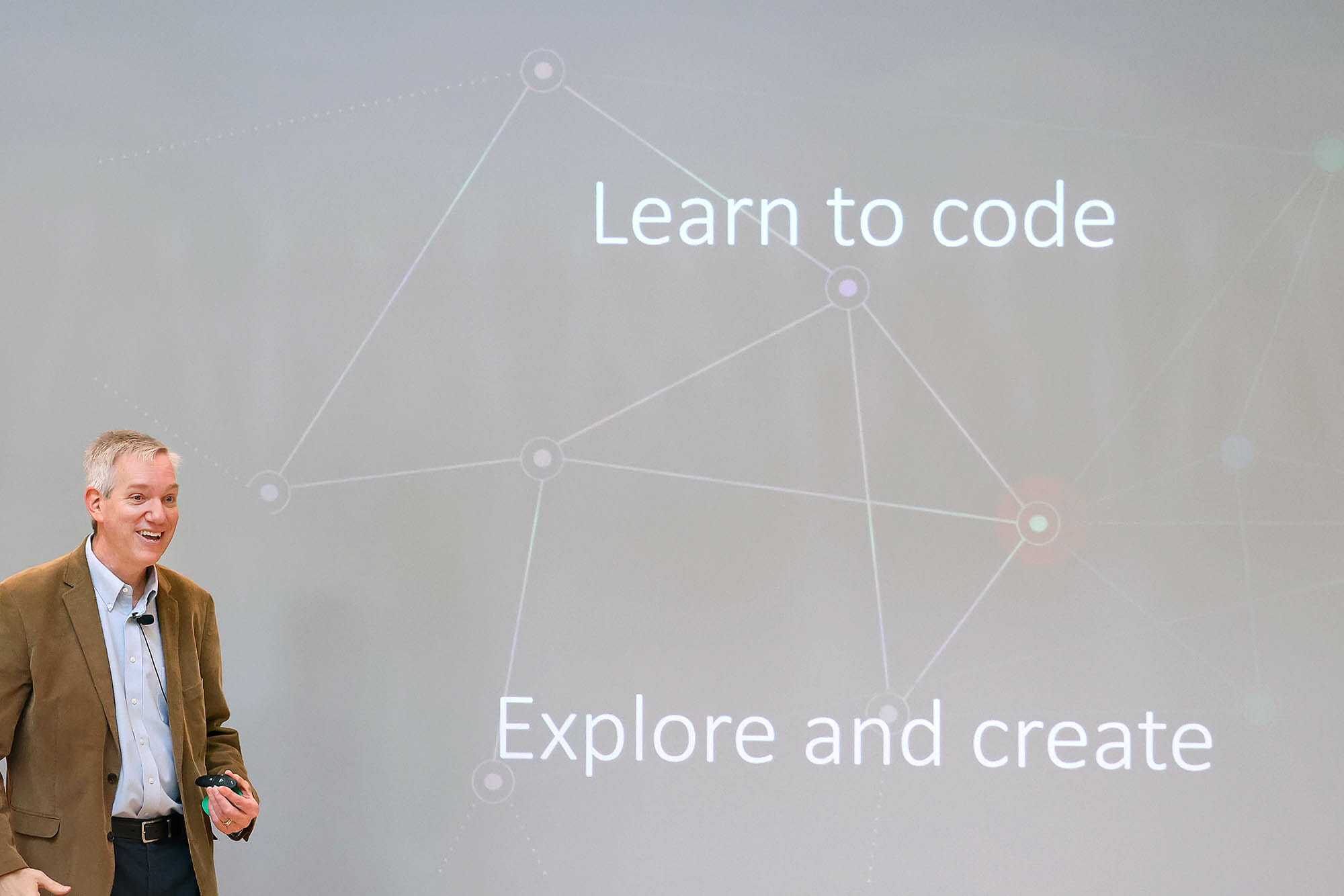
After answering some questions from the Upper Schoolers, Dr. Titus finished with a final question: „What is your adjacent possible? What’s your next step?“
Dr. Titus went on to teach a workshop for our math and science teachers that focused on machine learning and mathematics/computational instruction. He helped faculty better understand how machine learning works, what its advantages can be, and what its challenges for educators are. Upper School Computer Science Teacher Travis Menghini shared, „In the workshop, Dr. Titus introduced math and science faculty to AI Image recognition and gave us the opportunity to work with data sets. For example, I downloaded images of bowling balls, tennis balls, and racquetball rackets that I loaded into a program. This allowed the AI to learn what each of those sets of data looked like.“ This understanding equips educators to manage guidelines as machine learning impacts the classroom with tools like ChatGPT.
Titus also shared ways in which machine learning can facilitate deeper understanding of math and science concepts and how it can support helping students learn principles of coding and emerging technologies that will impact their future. He closed the faculty workshop by offering to engage in some ongoing research and learning with faculty or with our students.
Thank you, Dr. Titus, for sharing your wisdom, enthusiasm, and discoveries with us. We can’t wait to see what the adjacent possibilities are for our students after being inspired by you!
